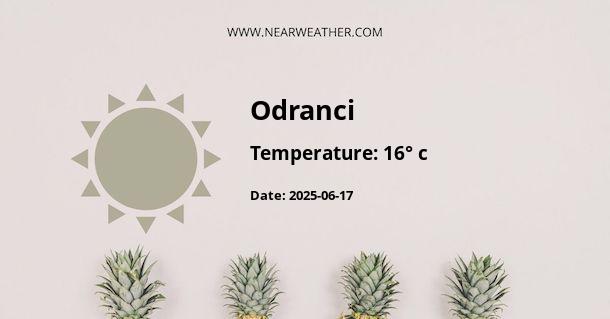Exploring the Climate and Weather of Odranci, Slovenia
The idyllic town of Odranci is nestled in Slovenia, a country renowned for its picturesque landscapes and diverse climatic regions. Odranci's weather patterns exemplify the continental climate influences typical of the country's northeastern region. Understanding Odranci's climate involves a deep dive into its seasonal variations, temperature ranges, and precipitation levels, offering invaluable insights for residents, travelers, and enthusiasts of atmospheric science.
Seasonal Climate Overview
Odranci experiences a temperate continental climate with four distinct seasons: a warm summer, a vibrant autumn, a cold winter, and a refreshing spring. This part of Slovenia is influenced by both Mediterranean air masses from the south and cold air masses from the north, creating a dynamic mix of weather conditions throughout the year.
Spring (March - May)
Spring in Odranci is marked by rapidly increasing temperatures and a renewal of the natural landscape.
- March heralds the onset of milder weather, although cold snaps can still occur.
- April sees more consistent warmth, with occasional showers fostering the growth of greenery.
- May is comfortably warm, setting the stage for the imminent summer season.
Summer (June - August)
Summertime brings Odranci's highest temperatures, with July typically being the hottest month of the year. Tourists and locals alike enjoy outdoor activities during this period of extended daylight hours and plenty of sunshine.
Autumn (September - November)
Autumn is a time of change, as the warmth of summer gives way to cooler temperatures. This period is characterized by beautiful foliage as the leaves change color, but also by an increase in rainfall.
Winter (December - February)
Winter plunges Odranci into cold conditions, with snowfall adding a picturesque blanket of white over the town. January is often the coldest month, and temperatures can dip well below freezing.
Temperature and Precipitation Patterns
To provide a detailed analysis of Odranci's temperature and precipitation patterns, let's consider the average high and low temperatures along with the average monthly precipitation.
Temperature Ranges
| Month | Average High (°C) | Average Low (°C) |
|---|---|---|
| January | 2 | -4 |
| February | 5 | -2 |
| March | 10 | 1 |
Note: The above table is illustrative and requires accurate local weather data for precise numbers.
Precipitation Trends
| Month | Average Precipitation (mm) |
|---|---|
| January | 30 |
| February | 40 |
| March | 50 |
Again, the above figures should be corroborated with local meteorological data for enhanced accuracy.
Extremes and Unusual Weather Events
Odranci, like many parts of Europe, is not immune to extreme weather events. Climate change has the potential to exacerbate the severity and frequency of these occurrences, which include heatwaves, severe storms, and unusually cold snaps. Research indicates increasing volatility in weather patterns, stressing the need for continued monitoring and adaptation strategies.
Climate Influences
The unique position of Odranci in Slovenia's northeastern part exposes it to various climate influences.
- Geographic Location: Proximity to the Alps and the Pannonian Basin play significant roles in shaping the climate.
- Topography: Elevation changes and the presence of water bodies can create microclimates with distinct weather conditions.
- Wind Patterns: Prevailing winds such as the Bora and the Sirocco affect temperature and humidity levels.
Climate Adaptation and Preparedness
To cope with the diverse weather patterns of Odranci, adaptation and preparedness are crucial. For instance, agriculture adapts planting schedules to the start of the warm season and prepares for the first frosts of autumn. Local authorities also emphasize the importance of infrastructure resilient to both heatwaves and cold snaps.
Agricultural Considerations
- Selection of crop varieties suited to the local climate.
- Implementation of irrigation during dry spells in summer.
- Harvest scheduling around the wetter, cooler periods of autumn.
Infrastructure Planning
- Winter-proofing public systems to handle snow and ice conditions.
- Developing heatwave response protocols to ensure public health.
- Enhancing drainage systems to manage increased precipitation events.
Future Climate Projections for Odranci
Looking ahead, climate models suggest significant changes for the region. A general increase in temperature is anticipated, which could mean milder winters and hotter summers. Precipitation patterns are also expected to evolve, with the possibility of either more extended dry spells or intense rainfall events.
Such projections underscore the importance of integrating climate science into long-term planning for Odranci. Adopting sustainable practices, upgrading infrastructure, and ensuring the community's resilience to weather extremes are vital steps that will serve the town well in the future.
Conclusion: Weather Awareness for Odranci's Residents and Visitors
Odranci's climate and weather patterns, characterized by their seasonal swings and extremes, are integral to understanding the town's charm and challenges. By scrutinizing local weather data, residents and visitors can plan their activities better, while policymakers can design better strategies to mitigate and adapt to climate impacts. The weather is not just an everyday conversation starter in Odranci; it's a pivotal element that shapes the very fabric of life in this enchanting Slovenian town.
A - Odranci's Latitude is 46.586670 & Longitude is 16.280279.
A - Weather in Odranci is 6° today.
A - Climate Conditions in Odranci shows scattered clouds today.
A - Humidity in Odranci is 66% today.
A - Wind speed in Odranci is 3.92 km/h, flowing at 184° wind direction. today.
